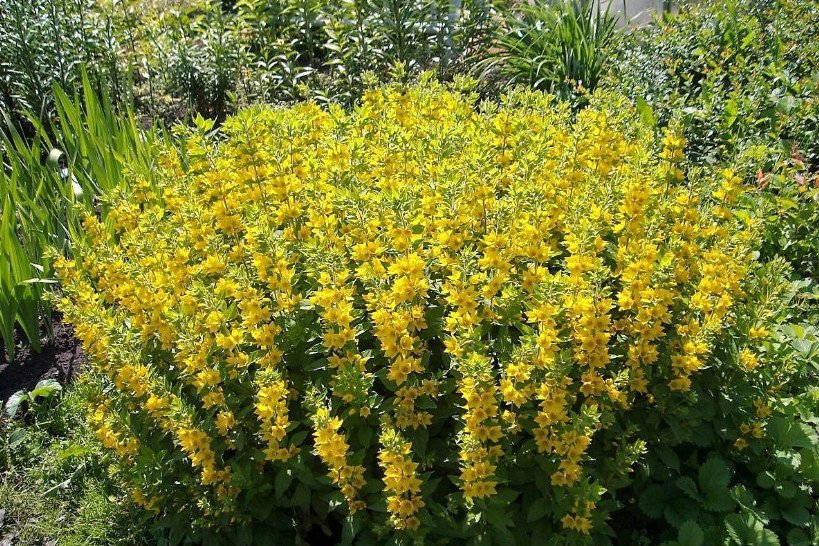
Many gardeners are familiar with some species of this plant from the genus Lysimachia Primrose family. Most often it is herbaceous perennials, of which there are 150 species. Occur in temperate climatic zones in the Northern hemisphere. For a long time some of their representatives are grown as decorative.
For many Lysimachias are characterized by some common features: bright yellow flowers, combined in inflorescences, straight strong stems, opposite simple leaves. But there are species that are significantly different. Therefore, it makes no sense to give a General description of the genus, let’s get acquainted with its different representatives.

Lysimachia vulgaris
It is widespread in nature and is most often found in our gardens. Forms a wide Bush, consisting of straight strong, slightly pubescent stems up to 1 m.
The oval leaves are arranged oppositely on a few pieces. Blooms from June to August, medium-sized bright yellow flowers, located around the stem. During flowering, the plant looks very impressive – the whole Bush consists of elongated inflorescences of yellow color.
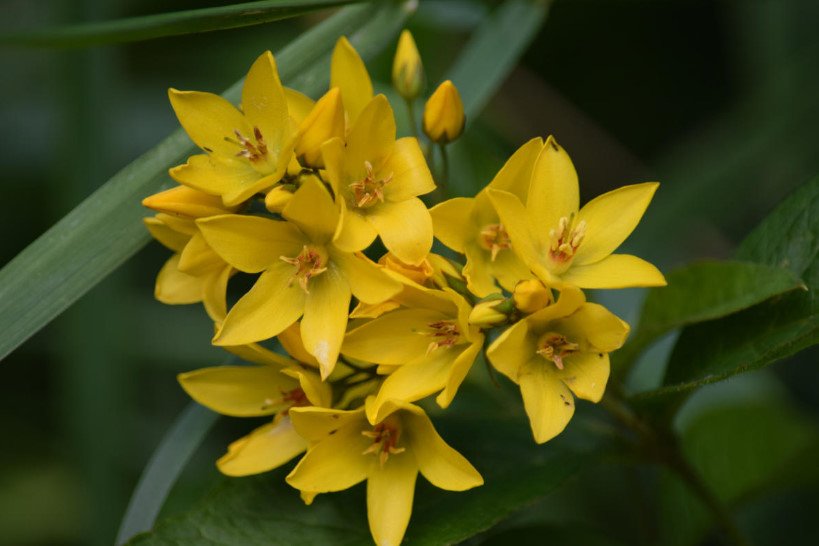
This kind of likes slightly shady places and loose, well-moistened soil. And even grows well in the water at a shallow depth, so it is well suited for placement on a flooded area or for the device decorative swamp in the garden.
Lysimachia nummularia
It is completely different from the previous view. This is a typical ground cover plant. Its stems about 30 cm raised above the ground not higher than 5 cm They trail over the soil, let the roots and thus spread quickly.
Leaves of this species are bright green and rounded, also sitting opposite. In mid-summer, small yellow flowers bloom on the shoots, making the rug from Lysimachia very elegant. Flowering lasts up to twenty days.

Very unpretentious and ornamental plant, quickly spreads, grows in the shade and in the open sun, can survive drought and flooding. There is a variety of ‘Aurea’ with Golden yellow leaves.
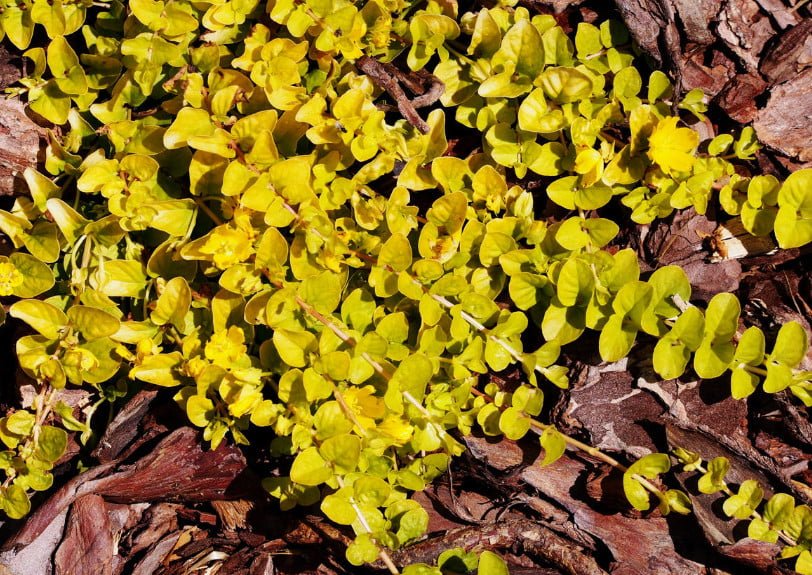
Lysimachia punctata
Familiar to gardeners. Perennial forms dense thick bushes of vertically standing straight and strong stems reaching a height of 80 cm and densely covered with oval-elongated leaves.
By the end of June, it reveals yellow flowers star-bell-shaped with an orange center, which cover all the shoots. At this time, the Bush becomes very decorative. Flowering lasts more than a month.
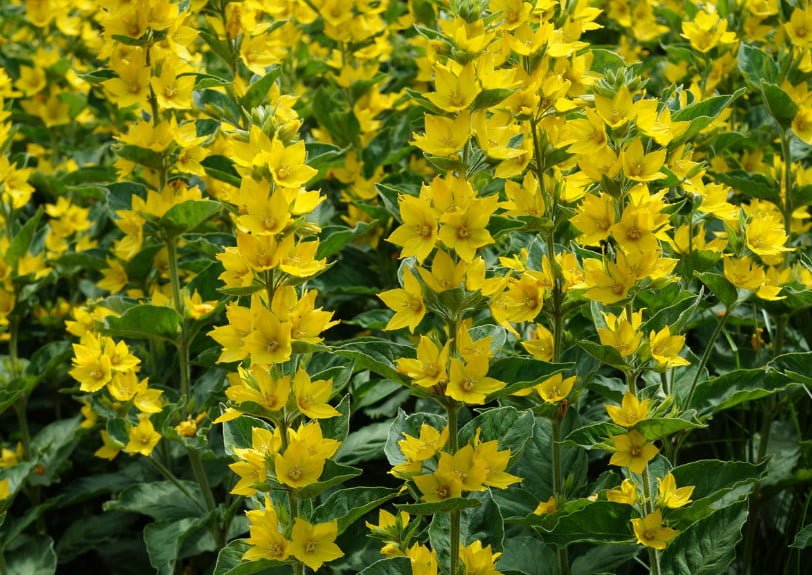
It grows better in a semi-shaded place on moist soil. Under favorable conditions, it can grow rapidly, and then it has to be limited, because it becomes aggressive and can displace neighboring plants.
Grade ‘Alexander’ has leaves with a white border, grade ‘Golden Alexander’ – yellow edging on the edge of the sheet.
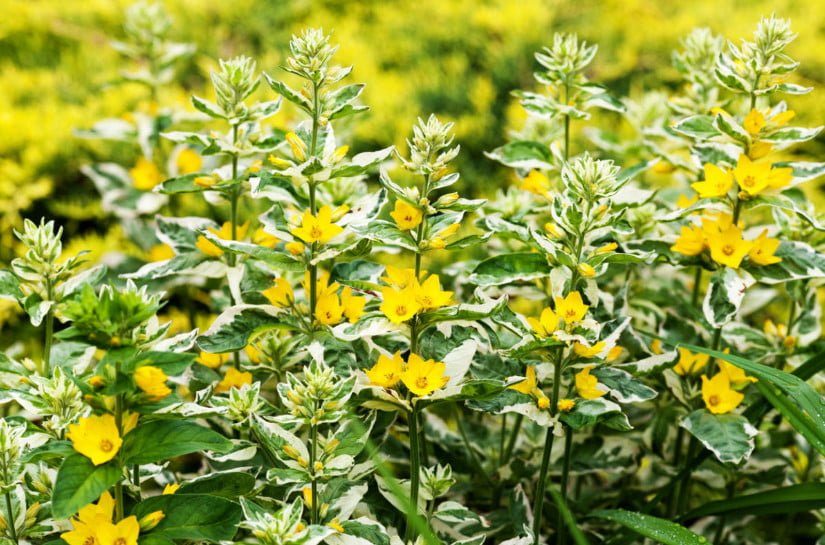
Lysimachia clethroides
It is found in orchards is much less. The Motherland of North-Eastern China.
Rhizomes of this plant is not so much grow, as in V. dot. Forms a strong straight, almost unbranched shoots, which are simple rounded leaves with a pointed tip.
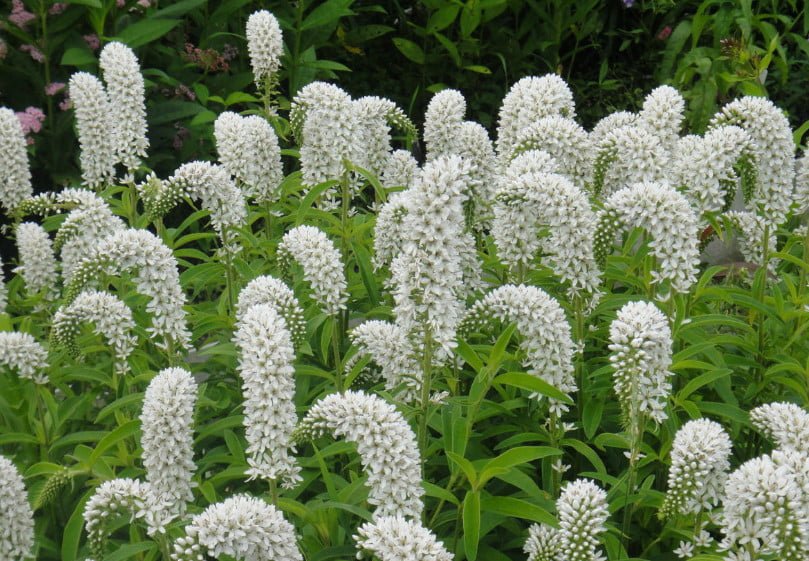
Blooms very beautiful: its small stellate white flowers form a pyramidal drooping inflorescence 25-30 cm long. Flowering lasts from the end of July about 20 days.
Sun-loving plant, but tolerates partial shade, it needs a deep layer of well-treated nutrient soil. The only variety of this species ‘Lady Jane’ has a higher height and large inflorescences.
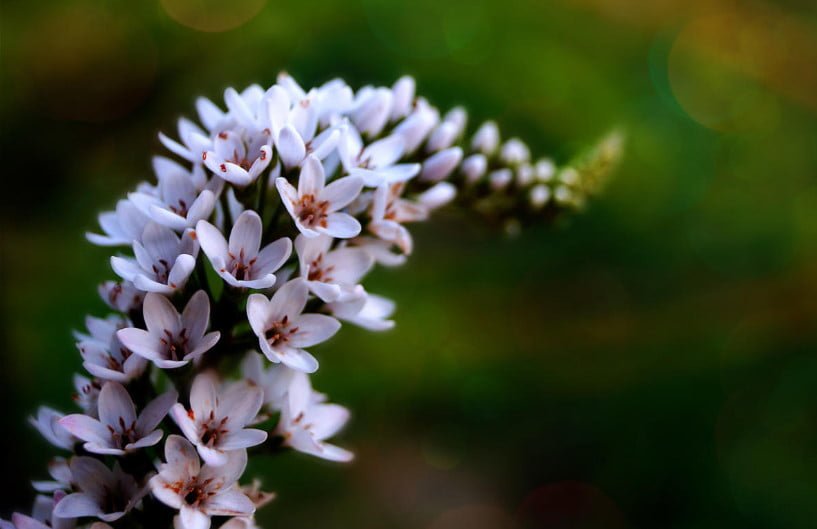
Lysimachia atropurpurea
This plant is from 45 to 90 cm tall. Unusual among other species is a perennial with spiky inflorescences of dark wine-red flowers, which create an amazing contrast to silvery-green leaves of lanceolate shape.
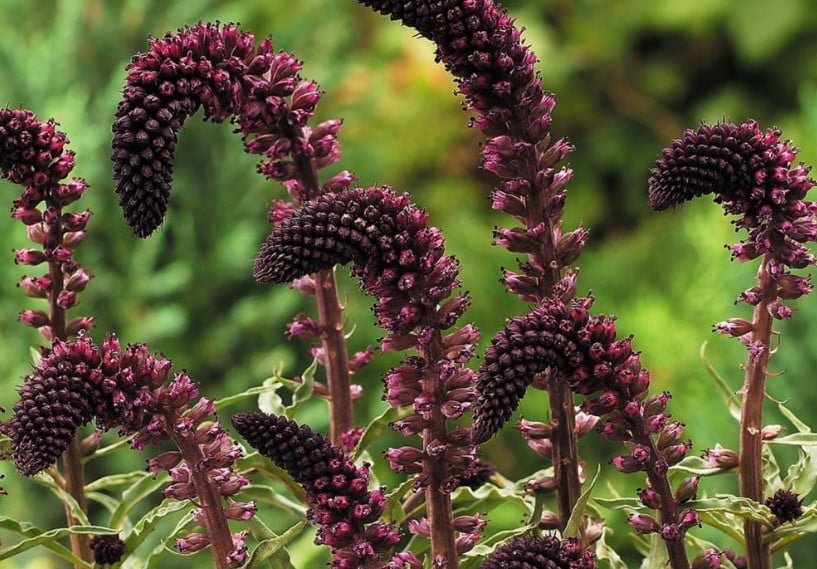
Its flowering lasts from July to August. Bred excellent variety ‘Beaujolais’ with drooping inflorescences of dark purple and light wavy on the edge of the sheet.
Lysimachia thyrsiflora
Another pretty decorative look. Grows up to 60 cm in height, the Bush is formed by straight strong shoots with growing on them narrowly-lanceolate leaves. Small yellow flowers, decorated with protruding stamens, form fluffy inflorescences. Flowering occurs in late may-early June.
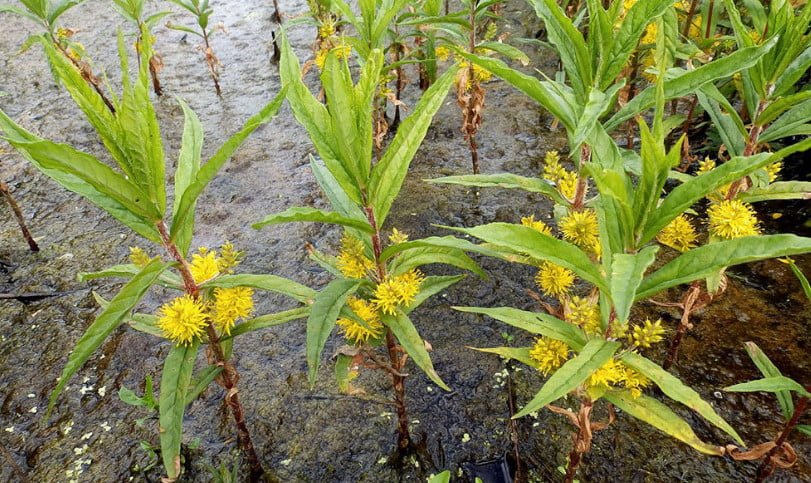
Lysimachia ciliata
Originally from North America. In horticulture, the sort of ‘Firecracker’ with purple coloured leaves.
Bush in height reaches 70 cm. its straight tetrahedral branching shoots are large (up to 12 cm in length) leaves. For him, it is preferable to a well-lit area, since it is in the light of its leaves acquire a beautiful chocolate-purple color, which in a shady place fades.
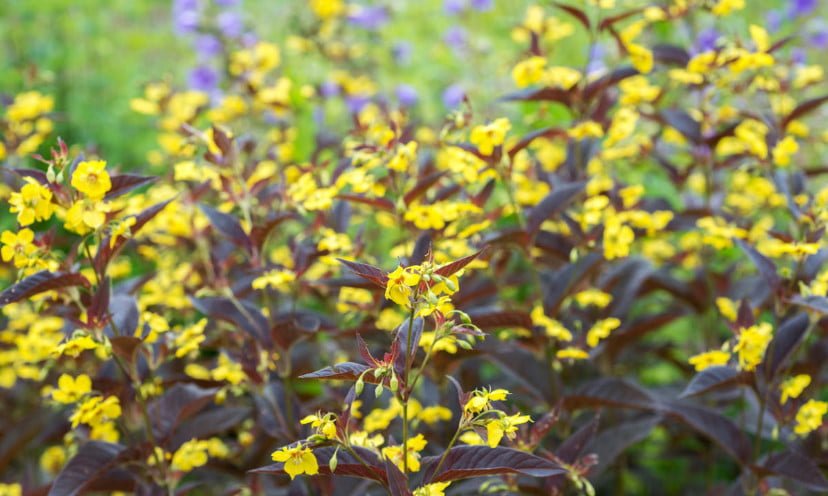
Although its flowers are small and inconspicuous, but collected in a loose inflorescence, coupled with bright leaves, make the plant very spectacular, especially against the background of plants with green foliage. Grows well in moist fertile soil, suitable for landscaping of a coastal strip around ponds.
Growing Lysimachia in the garden
There are some rules for successful breeding of Lysimachia.
- Almost all decorative Lysimachia prefer a semi-shaded place, bright light is needed only by Lysimachia atropurpurea. Lysimachia nummularia also grows well in the sun, but under the trees grows lush.
- They are not particularly demanding on soils, but will develop better on rich organic matter, well-moistened, loose soil. The layer of such soil can be quite shallow-only 15 cm, as the root system of their surface.
- Constant hydration is very important for Lysimachia, and some species will grow in water.
- When planting Lysimachia in the garden, it should be borne in mind that they grow quickly, they need constant monitoring so that they do not drown out other, less aggressive plants.
- In autumn, the aboveground part of the bushes are cut, sprinkled with humus. Shelter for the winter plants do not require.
Reproduction
Lysimachia easily propagated vegetatively: the division of the Bush, growing to the side offspring, as well as part of the rhizomes. Usually reproduction is carried out in the spring or early autumn. In the spring of Lysimachia and can be cut, using young shoots regrowing.
Seeds propagated rarely, and it is better to do it in late autumn sowing directly into the ground-so the seeds will be natural stratification.
Spring sowing (surface) is carried out in February-March in a container with loose soil containing sand, garden soil and peat. Boxes with crops placed for a month in the refrigerator, then put on a light windowsill.
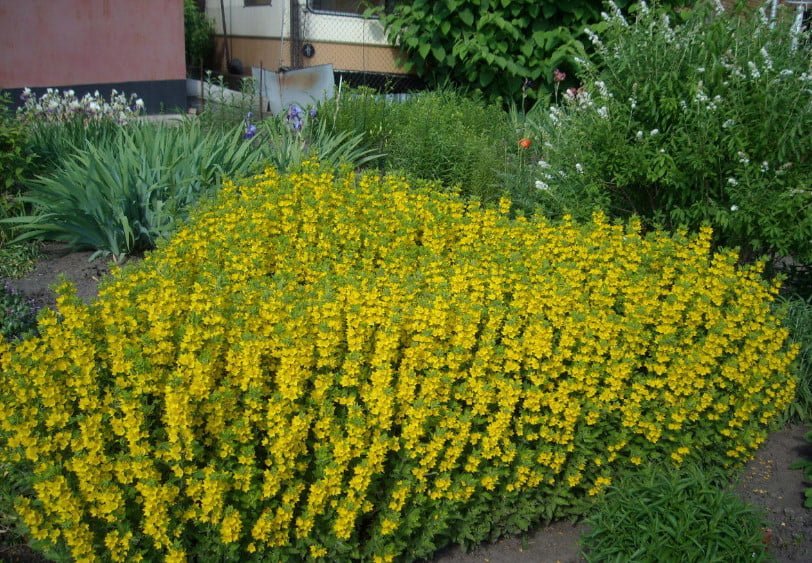
Germination occurs at a temperature of + 18…+20 C. Seedlings dive into the open ground transplanted in early June. Flowering begins at 2-3 years. Lysimachia should not be transplanted often-they can stay in the same place for ten years.
Lysimachia in the garden
Lysimachia will find on the plot different applications. Lysimachia vulgaris and Lysimachia punctata will look good in a mixborder, especially beautiful combination of yellow inflorescences with blue flowers, as well as with paniculate inflorescences of different shades.
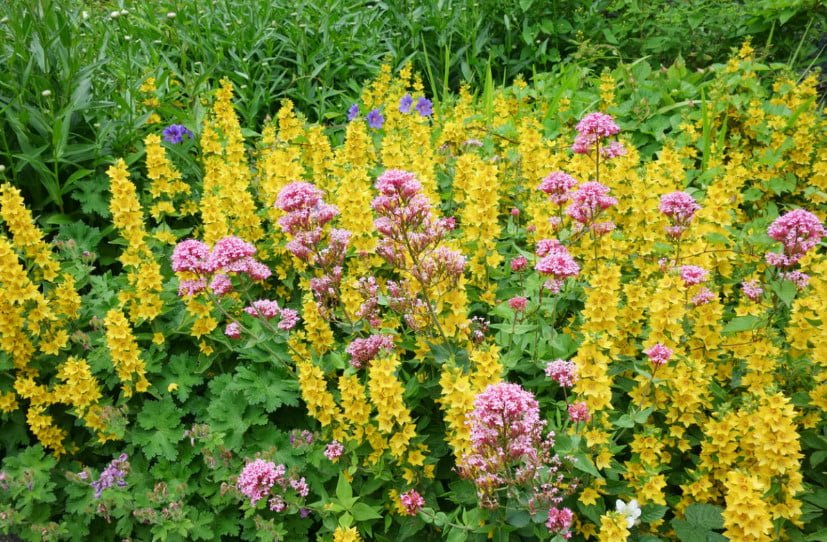
Lysimachia ciliata varieties ‘Firecracker’ goes well with plants that have foliage bluish and bluish shades. White Lysimachia clethroides suitable for white garden in combination with other white and silver plants, and it will look beautiful next to the bright colors.
Lysimachia nummularia is good as a ground cover plant in a shady corner of the garden or near the pond – its creeping shoots will beautifully spread over the rocks and swim in the water. Looks great Lysimachia nummularia and in pots, where it grows rapidly and acts as an ampelnoe plant.

Choose your favorite Lysimachia and decorate your garden with them!
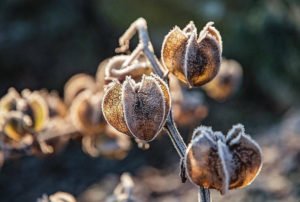
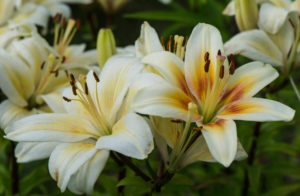
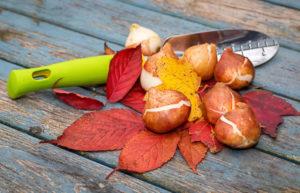
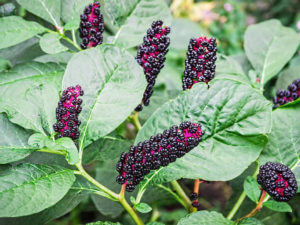
Leave a Reply